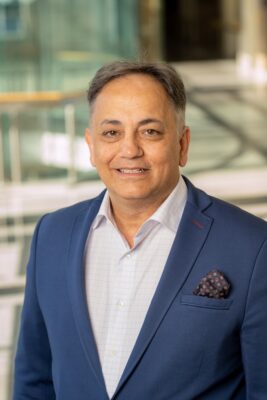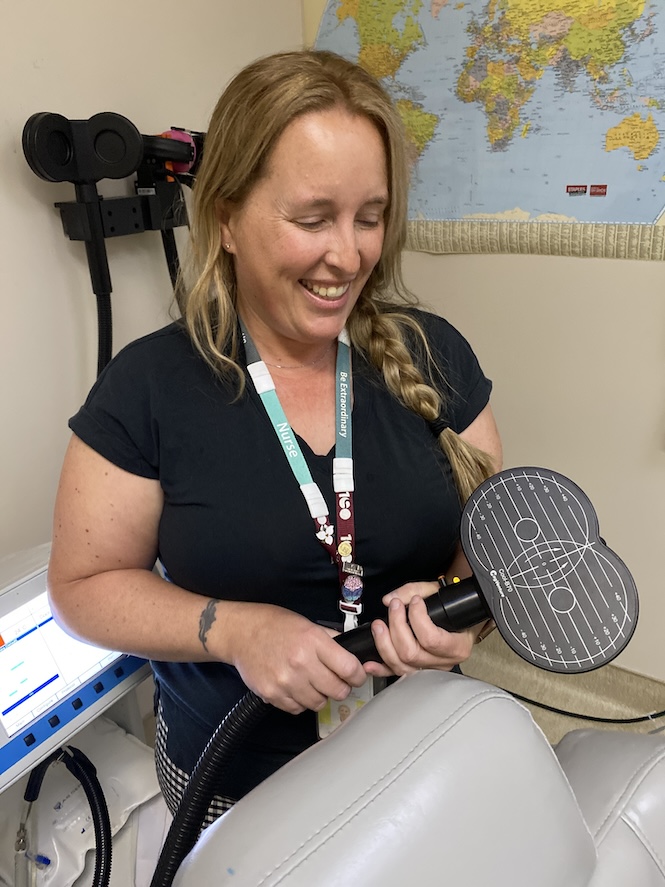TMS (or rTMS) is a non-invasive treatment option for treatment-resistant depression. It delivers short magnetic pulses directed at the brain to stimulate nerve cells. Patients can return to their regular activities immediately following treatment, which lasts about three to eight minutes. Ontario Shores operates two of these machines – one at the main campus in Whitby and another at the Mackenzie Richmond Hill Hospital clinic.
How does it work?
The magnetic coil is placed close to the left side of the head (near the left dorsolateral prefrontal cortex). Abnormalities in networks originating from this region have been identified as the pathological basis of depression.
Over three minutes, short, theta bursts emit from the coil, stimulating the area. This process is repeated daily for about six weeks, and the results are promising for many who live with debilitating depression.
Does it hurt?
Reactions vary from patient to patient. Most find it similar to the little zaps you might feel from a TENS machine, which physiotherapists use to feed a low, electrical pulse through electrodes attached to your body.
What a session is like
You might expect a more elaborate setup for a treatment room where a state-of-the-art machine sends stimulation into your brain in a precise way to target the microscopic nerve cells involved in mood control and depression. However, all you will find in this small room is a seat resembling a barber’s chair and an electronic box about the size of a large bread box. But don’t let the lack of racks of equipment fool you. This room has changed many lives.
Karen, a patient, entered the Brain Stimulation Clinic at Ontario Shores on a sunny afternoon in August for a follow-up session. She was cracking jokes with Janice, the TMS technician, in no way demonstrating any traits consistent with someone with debilitating depression. She quickly got comfortable, obviously having done this dozens of times already.
Receiving treatment
“Given my condition at the time,” Karen explained, “my success rate was not all that promising, but thank goodness those worries turned out to be wrong. TMS has been a lifesaver for me.”
In fact, Karen would use the term “lifesaver” several times during this session.
Diagnosed with post-traumatic stress disorder and depression, Karen says she was a completely different person.
“I was on six anti-depressants at one time. I wasn’t the person my husband knew. I wasn’t the person I knew myself to be.”
All this time, she had been settling back into the chair while Janice was marking pre-determined points on Karen’s forehead that would provide an exact location for the magnetic coils to be placed. She placed her glasses on the counter and laid back with seemingly no concerns at all.
Then, just like that, the session had begun. Karen continued talking away with Janice as though they were sharing a bus ride. The only indications that something was happening were three quick, high-pitched beeps from the control unit and 10 quick buzzing sounds of the theta bursts. This process would repeat several more times. Then, three minutes and eight seconds later, it was over. In the meantime, Karen had not stopped the conversation and did not acknowledge that she had just undergone an entire session.
TMS treatment from patient Barbara’s perspective
She sits at a table in the corner of a coffee shop with a pad full of notes. On the dog-eared pages, almost a year’s worth of questions asked and answers given. This is a 70-year-old woman who describes the last 15 years of her life as “hell.” In fact, she envisions herself as “a Phoenix, rising from ashes.”
“I’ve been a Phoenix many times over the last 15 years. I’ve lost so much,” she explains. “I have fought to find meaning, hope and a measure of peace.”
Her name is Barbara Allentoff. A survivor of two bouts of cancer. But it was the death of her 20-year-old son, Matthew, in 2010 that sent her spiralling downward into a deep depression.
“Until all this happened, I was a balabusta (a Yiddish expression describing a woman who runs her kitchen and everyone comes to for advice), but I quickly lost all interest and purpose in my life.”
Barbara managed to rebound somewhat, but then came the pandemic. This time, her downfall was more severe.
She left the choir she loved so much, and her love for volunteering disappeared. Her days were spent weeping, and with each tear, hope faded. With the loss of her entire family, she could no longer claim to be a balabusta.
Then she heard about the TMS clinic offered by Ontario Shores. It had done wonders for a friend of hers. From there, things happened pretty fast. In November of 2023, her doctor submitted a referral for her. In the first week of January 2024, she met with Dr. Amer Burhan, then Ontario Shores’ Physician-in-Chief and the leader of the TMS program. Shortly after that, she sat in a comfortable chair in the Ontario Shores TMS clinic at Mackenzie Health in Richmond Hill and received treatment five days per week for six weeks. Each treatment lasted less than 10 minutes. It was non-invasive; she only felt a slight thumping from the magnetic coil. Within four days of treatment, she felt a glimmer of hope. Three weeks later, she realized her “rise out of the ashes” had truly begun.
Back at the coffee shop, Barbara is a woman reborn.
“A year ago,” she says, “you would have been sitting here with a very different Barbara. I was so very sad. I was tired, not just physically. My soul was tired! Now, I see gratitude every day in life. I am journaling. If I had to write a book about my life, the title would be ‘Rising from the Ashes: How to Get the Dust Off Your Shoulders. ‘
Barbara is back with her beloved choir and volunteering again. She has regained her purpose, peace, and place as a balabusta with her extended family.

TMS treatment from Dr. Amer Burhan’s perspective
“This treatment has given Barbara her life back.”
Dr. Burhan has made it his life’s work to understand and help stimulate some of the 100 million neurons in the average human brain, each 50 times smaller than the diameter of a human hair.
Further, he must try to adjust the activity of some of the 100 trillion synaptic connections, where neurons connect and communicate. Compare that number with our Milky Way Galaxy’s measly 100 billion stars.
Dr. Burhan leads one of Ontario Shores’ two TMS clinics. He was one of the first clinicians Barbara encountered as she prepared for treatment.
“She was already on two medications,” Dr. Burhan recalls, “neither of which was doing much for her severe depression.”
Dr. Burhan knows that TMS cannot be a stand-alone solution.
“By combining TMS with psychotherapy, they are complimentary to each other. We can target the brain’s cognitive networks more
effectively.”
He had to decide if TMS therapy was the right option for Barbara. While it boasts a 50 percent success rate, patients must be carefully selected.
Barbara is one of the success stories.
“[In Barbara’s case] This treatment has given her life back to her.”
*This story was shared with the permission of all parties involved.


